The recent spate of typhoons that have battered the Philippines since the last quarter of the year has highlighted several critical lessons and underscored the urgent need for enhanced resilience strategies.
Key Lessons:
- Importance of Early Warning Systems:
- Reliable and Timely Alerts: Accurate and timely weather forecasts and warnings are essential to save lives.
- Effective Dissemination: Ensuring warnings reach vulnerable communities, especially remote areas, is crucial.
- Strengthening Infrastructure:
- Robust Infrastructure: Investing in resilient infrastructure, such as flood control systems, seawalls, and sturdy housing, can significantly mitigate the impact of typhoons.
- Building Codes: Enforcing strict building codes and standards can help structures withstand strong winds and heavy rainfall.
- Community-Based Disaster Risk Reduction (CBDRR):
- Empowering Communities: Engaging communities in disaster preparedness and response planning can enhance their resilience.
- Evacuation Drills: Regular drills can help communities respond effectively to emergencies.
- Climate Change Adaptation:
- Long-Term Planning: Recognizing the increasing frequency and intensity of typhoons due to climate change, long-term adaptation strategies are necessary.
- Ecosystem-Based Adaptation: Protecting and restoring ecosystems, such as mangroves and coral reefs, can help buffer the impact of storms.
- Effective Governance and Coordination:
- Strong Leadership: Strong leadership and coordination among government agencies, NGOs, and the private sector are essential for effective disaster response.
- Transparent Governance: Transparent governance and accountability can ensure efficient use of resources and effective implementation of policies.
Building Resilience:
To build resilience, the Philippines must prioritize the following strategies:
- Investing in Science and Technology: Advancements in weather forecasting and early warning systems can significantly improve preparedness.
- Promoting Sustainable Land Use: Sustainable land use practices, such as reforestation and conservation agriculture, can help reduce vulnerability to natural disasters.
- Strengthening Social Safety Nets: Social protection programs can help vulnerable communities recover from disasters.
International Cooperation: Collaborating with international partners can facilitate knowledge sharing, technology transfer, and financial support.


